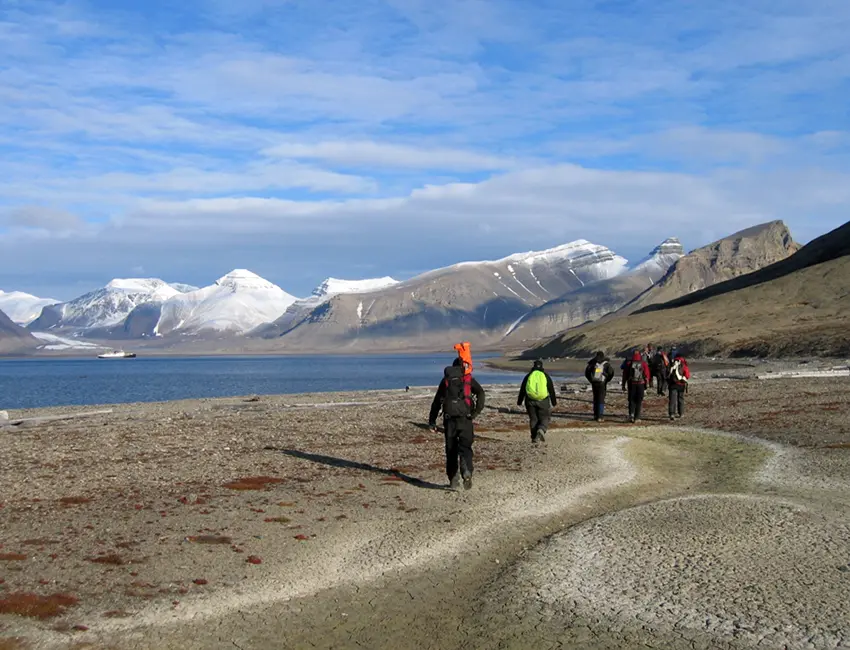AG-336 Rift Basin Reservoirs: From Outcrop to Model (10 ECTS)
ID:
AG-336
CREDITS:
10 ECTS
APPLICATION DEADLINE:
March 01, 2025
START DATE:
August 11, 2025
END DATE:
September 19, 2025
COURSE PERIOD:
Autumn semester. Teaching block 5

AG-336/836 excursion to Liefdefjorden. Photo: Per Terje Osmundsen/UNIS.
| Grade: | Letter grade (A through F) |
| Course Cost: | Fieldwork, NOK 1600–2000 (8–10 days x NOK 200 per overnight stay) |
| Course Capacity Min/Max: | 10/20 students (AG-336/836 in total) |
| Language of instruction: | English |
| Examination support material: | Bilingual dictionary between English and mother tongue |
Contact person
Course requirements
Enrolment in a relevant master programme. General background in structural geology and sedimentology. Previous geological field experience is required.
Academic content
Rift basins are among the most common hydrocarbon and groundwater plays, or CO2 storage sites. Thus they represent important geological settings in an economic perspective, and may as well play an important role in future CO2 emission reduction scenarios. Successful exploration and production/injection in rift basins requires a sound understanding of their three-dimensional architecture and their geological evolution through time. Emphasis is put on how extensional basin architecture develops as a function of fault growth and linkage and how sedimentary systems respond to the topographic gradients produced by faults. Thus, the effects of faulting on sedimentation are central topics. Furthermore, we focus on the effect of faulting on reservoir properties, on acquisition and compilation of outcrop data, on seismic expressions of rift basins, and on the use of geological information in reservoir models.
Learning outcomes
Upon completing the course, the students will:
Knowledge
- have a broad knowledge of the structural and sedimentary architecture of rift basins and their assessment, covering the petroleum, groundwater and CO2 storage perspective
- have obtained insight in a number of fundamental basin-forming processes, in particular structural evolution and the evolution of tectonic geomorphology and depositional patterns characteristic for extending areas
- acquire a fundamental understanding for different types of rift basins, their evolutionary stages and resulting configuration of sedimentary rocks
- be able to translate this knowledge into scenarios for petroleum exploration, ground water extraction or CO2 injection, including reservoir characteristics and risk evaluation
- have detailed knowledge of an onshore analogue to the deep rift basins of the Barents Sea.
Skills
- be able to measure and analyse tectonic and sedimentary structures in the field, and to construct detailed logs through successions of sedimentary rocks
- be able to use different types of geological data (structural, sedimentological) to reconstruct the architecture and the general tectonic and depositional history of a rift basin
- have been introduced to the interpretation of rift basins in seismic reflection data
- be able to translate the geology of a rift basin into a series of petroleum exploration plays and to have evaluated these plays in terms of potential resources and risks.
General competences
- fundamental competence in the design and execution of an independent field-based research project, including compilation of literature and the planning and execution of field activities
- experienced the challenges of teamwork involving mixed geological backgrounds and skills
- strengthened their ability to think across disciplines and to implement cross-disciplinary concepts in a teambased workflow.
Learning activities
The course extends over ca. 5 weeks including compulsory safety training and is run in combination with AG-836.
We use world-class exposures in Svalbard to illustrate the architecture and processes of rift basins. In the series of lectures and exercises, rift basins are placed in the context of evolutionary models for extensional systems and rifted margins. The introductory lessons will be followed by field studies in the Billefjorden Trough, an excellently exposed rift basin in Svalbard. This Carboniferous half-graben hosts marginal sandstones as well as carbonates, evaporites and shales. Several types of source- and reservoir rocks will be explored. The participants will work in teams to record outcrop data and develop their own case study of a rift-basin reservoir. The Arctic climate and the variable topography in the field area require that students are fit and equipped to face the environment.
The fieldwork will be followed by compilation and evaluation of surface and subsurface data. Finally, the students will use their own field observations to evaluate play models in a graded written report and presentation.
Summary
- Total lecture and exercise hours: Ca. 40 hours.
- Excursion and fieldwork: Ca. 8–10 days.
Compulsory learning activities
All compulsory learning activities must be approved in order to sit the exam.
- Fieldwork
- Exercises
- Presentations
Assessment
- All assessments must be passed in order to pass the course.
- Each assessment is graded, and subsequently combined into a single grade. Partial grades for each assessment will be available.
| Method | Duration |
Percentage of final grade
|
| Written exam | 3 hours | 80% |
| Graded report | 20 % |
Student life

